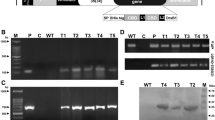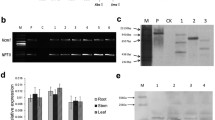Abstract
Ace-AMP1 is a potent antifungal peptide found in onion (Allium cepa) seeds with sequence similarity to plant lipid transfer proteins. Transgenic plants over-expressing Ace-AMP1 gene have enhanced disease resistance to some fungal pathogens. However, mass production in heterologous systems and in vitro application of this peptide have not been reported. In this study, Ace-AMP1 was highly expressed in a prokaryotic Escherichia coli system as a fusion protein. The purified protein inhibited the growth of many plant fungal pathogens, especially Alternaria solani, Fusarium oxysporum f. sp. vasinfectum, and Verticillium dahliae. The inhibitory effect was accompanied by hyphal hyperbranching for V. dahliae but not for F. oxysporum f. sp. vasinfectum and A. solani, suggesting that the mode of action of Ace-AMP1 on different fungi might be different. Application of Ace-AMP1 on tomato leaves showed that the recombinant protein conferred strong resistance to the tomato pathogen A. solani and could be used as an effective fungicide.





Similar content being viewed by others
References
Baroffio CA, Siegfried W, Hilber UW (2003) Long-term monitoring for resistance of Botryotinia fuckeliana to anilinopyrimidine, phenylpyrrole, and hydroxyanilide fungicides in Switzerland. Plant Dis 87(6):662–666
Bi YM, Cammue BPA, Goodwin PH, KrishnaRaj S, Saxena PK (1999) Resistance to Botrytis cinerea in scented geranium transformed with a gene encoding the antimicrobial protein Ace-AMP1. Plant Cell Rep 18(10):835–840
Borges JP, Culerrier R, Aldon D, Barre A, Benoist H, Saurel O, Milon A, Didier A, Rougé P (2010) GATEWAYTM technology and E. coli recombinant system produce a properly folded and functional recombinant allergen of the lipid transfer protein of apple (Mal d 3). Protein Expr Purif 70(2):277–282
Broekaert WF, Cammue BPA, De Bolle MFC, Thevissen K, De Samblanx GW, Osborn RW (1997) Antimicrobial peptides from plants. Crit Rev Plant Sci 16(3):297–323
Cammue BPA, Thevissen K, Hendriks M, Eggermont K, Goderis IJ, Proost P, Van Damme J, Osborn RW, Guerbette F, Kader JC, Broekaert WF (1995) A potent antimicrobial protein from onion seeds showing sequence homology to plant lipid transfer proteins. Plant Physiol 109(2):445–455
Capparelli R, Palumbo D, Iannaccone M, Ventimiglia I, Di Salle E, Capuano F, Salvatore P, Amoroso MG (2006) Cloning and expression of two plant proteins: similar antimicrobial activity of native and recombinant form. Biotechnol Lett 28(13):943–949
Castro MS, Fontes W (2005) Plant defense and antimicrobial peptides. Protein Pept Lett 12(1):11–16
Copping LG, Duke SO (2007) Natural products that have been used commercially as crop protection agents. Pest Manag Sci 63(6):524–554
García-Olmedo F, Molina A, Segura A, Moreno M (1995) The defensive role of nonspecific lipid-transfer proteins in plants. Trends Microbiol 3(2):72–74
Ge XC, Chen JC, Sun CR, Cao KM (2003) Preliminary study on the structural basis of the antifungal activity of a rice lipid transfer protein. Protein Eng 16(6):387–390
Gullino ML, Leroux P, Smith CM (2000) Uses and challenges of novel compounds for plant disease control. Crop Prot 19(1):1–11
Gurr SJ, Rushton PJ (2005) Engineering plants with increased disease resistance: how are we going to express it? Trends Biotechnol 23(6):283–290
Hadacek F, Greger H (2000) Testing of antifungal natural products: methodologies, comparability of results and assay choice. Phytochem Anal 11(3):137–147
Horsfield A, Wicks T, Davies K, Wilson D, Paton S (2010) Effect of fungicide use strategies on the control of early blight (Alternaria solani) and potato yield. Australas Plant Pathol 39(4):368–375
Jayaraj J, Punja ZK (2007) Combined expression of chitinase and lipid transfer protein genes in transgenic carrot plants enhances resistance to foliar fungal pathogens. Plant Cell Rep 26(9):1539–1546
Knight SC, Anthony VM, Brady AM, Greenland AJ, Heaney SP, Murray DC, Powell KA, Schulz MA, Spinks CA, Worthington PA, Youle D (1997) Rationale and perspectives on the development of fungicides. Annu Rev Phytopathol 35:349–372
Li XQ, Gasic K, Cammue B, Broekaert W, Korban SS (2003) Transgenic rose lines harboring an antimicrobial protein gene, Ace-AMP1, demonstrate enhanced resistance to powdery mildew (Sphaerotheca pannosa). Planta 218(2):226–232
Marx F, Binder U, Leiter É, Pócsi I (2008) The Penicillium chrysogenum antifungal protein PAF, a promising tool for the development of new antifungal therapies and fungal cell biology studies. Cell Mol Life Sci 65(3):445–454
Meyer V (2008) A small protein that fights fungi: AFP as a new promising antifungal agent of biotechnological value. Appl Microbiol Biotechnol 78(1):17–28
Novagen (2002) pET Manual. 10th edition. Merck, Darmstadt, Germany
Park SY, Jauh GY, Mollet JC, Eckard KJ, Nothnagel EA, Walling LL, Lord EM (2000) A lipid transfer-like protein is necessary for lily pollen tube adhesion to an in vitro stylar matrix. Plant Cell 12(1):151–163
Pokoj S, Lauer I, Fötisch K, Himly M, Mari A, Enrique E, Miguel-Moncin MDS, Lidholm J, Vieths S, Scheurer S (2010) Pichia pastoris is superior to E. coli for the production of recombinant allergenic non-specific lipid-transfer proteins. Protein Expr Purif 69(1):68–75
Schaefer SC, Gasic K, Cammue B, Broekaert W, van Damme EJM, Peumans WJ, Korban SS (2005) Enhanced resistance to early blight in transgenic tomato lines expressing heterologous plant defense genes. Planta 222(5):858–866
Scheurer S, Pastorello EA, Wangorsch A, Kästner M, Haustein D, Vieths S (2001) Recombinant allergens Pru av 1 and Pru av 4 and a newly identified lipid transfer protein in the in vitro diagnosis of cherry allergy. J Allergy Clin Immunol 107(4):724–731
Schocker F, Lüttkopf D, Scheurer S, Petersen A, Cisteró-Bahima A, Enrique E, San Miguel-Moncín M, Akkerdaas J, van Ree R, Vieths S, Becker WM (2004) Recombinant lipid transfer protein Cor a 8 from hazelnut: a new tool for in vitro diagnosis of potentially severe hazelnut allergy. J Allergy Clin Immunol 113(1):141–147
Spelbrink RG, Dilmac N, Allen A, Smith TJ, Shah DM, Hockerman GH (2004) Differential antifungal and calcium channel-blocking activity among structurally related plant defensins. Plant Physiol 135(4):2055–2067
Sterk P, Booij H, Schellekens GA, Van Kammen A, De Vries SC (1991) Cell-specific expression of the carrot EP2 lipid transfer protein gene. Plant Cell 3(9):907–921
Stevenson WR (1994) The potential impact of field resistance to early blight on fungicide inputs. Am Potato J 71(5):317–324
Tassin S, Broekaert WF, Marion D, Acland DP, Ptak M, Vovelle F, Sodano P (1998) Solution structure of Ace-AMP1, a potent antimicrobial protein extracted from onion seeds. Structural analogies with plant nonspecific lipid transfer proteins. Biochemistry 37(11):3623–3637
Thoma S, Hecht U, Kippers A, Botella J, De Vries S, Somerville C (1994) Tissue-specific expression of a gene encoding a cell wall-localized lipid transfer protein from Arabidopsis. Plant Physiol 105(1):35–45
Thomma BPHJ, Cammue BPA, Thevissen K (2003) Mode of action of plant defensins suggests therapeutic potential. Curr Drug Targets Infect Disord 3(1):1–8
Yamada M (1992) Lipid transfer proteins in plants and microorganisms. Plant Cell Physiol 33(1):1–6
Yang XY, Xiao YH, Wang XW, Pei Y (2007) Expression of a novel small antimicrobial protein from the seeds of motherwort (Leonurus japonicus) confers disease resistance in tobacco. Appl Environ Microbiol 73(3):939–946
Acknowledgments
We thank Dr. Jingao Dong at Hebei Agricultural University for kindly providing plant fungal pathogens, Dr. Hong Ma at Fudan University for helpful suggestions and manuscript editing, and Dr. Ping Xu at The Samuel Roberts Noble Foundation for language revision. This research was funded by National Natural Science Foundation of China (Grant No.30370297 and No. 30770425).
Author information
Authors and Affiliations
Corresponding author
Rights and permissions
About this article
Cite this article
Wu, Y., He, Y. & Ge, X. Functional characterization of the recombinant antimicrobial peptide Trx-Ace-AMP1 and its application on the control of tomato early blight disease. Appl Microbiol Biotechnol 90, 1303–1310 (2011). https://doi.org/10.1007/s00253-011-3166-x
Received:
Revised:
Accepted:
Published:
Issue Date:
DOI: https://doi.org/10.1007/s00253-011-3166-x




